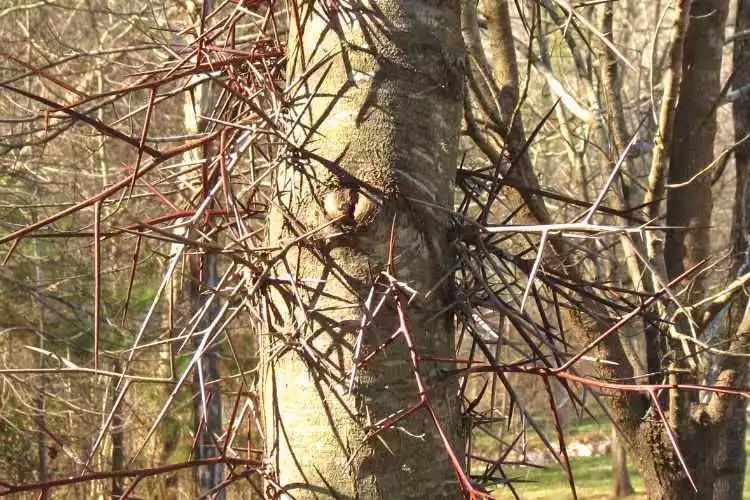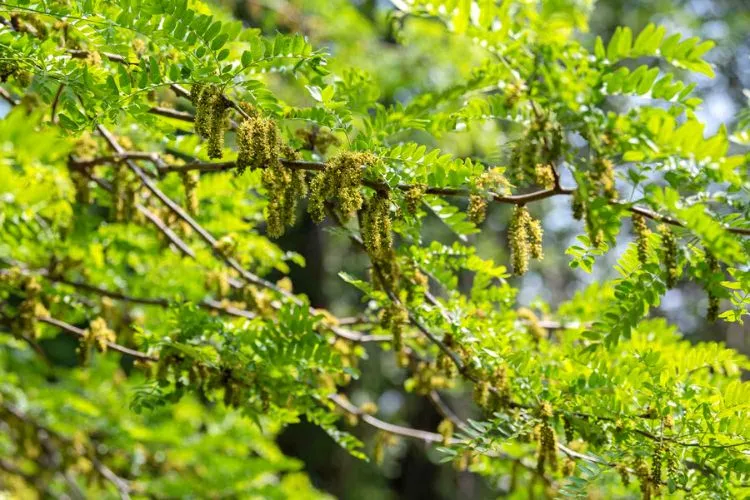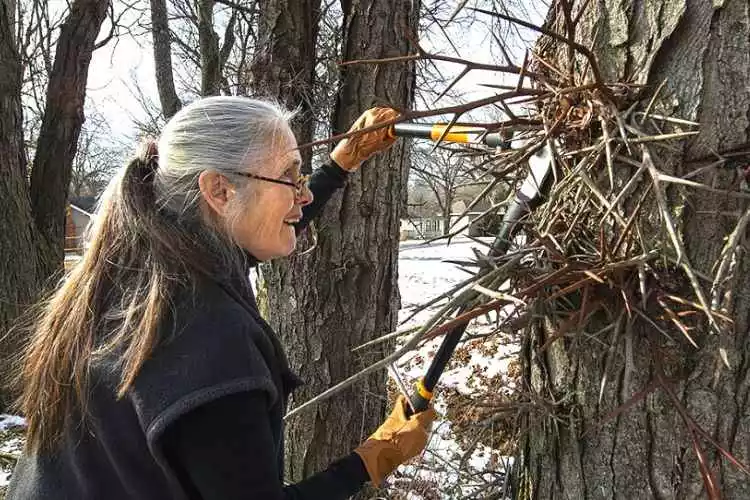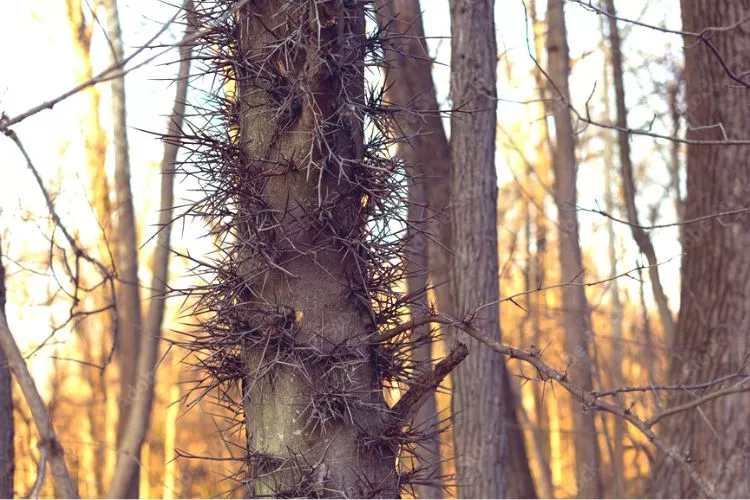To put it simply, firewood is a wood or a wooden material that can be used as fuel while it burns. So, if you are thinking about cutting off an old honey locust tree, let’s learn about its uses at a glance first.
Honey locust has been used widely as firewood in many countries. It’s a thorny deciduous tree primarily found in North America. This plant is often found in the ground near certain bodies of water, such as the coast or riverbanks.

You must have been familiar with its widespread uses as fence posts, pallets, and tool handles. However, honey locust is one of the most amazing firewoods resistant to decay. Let’s understand more about the characteristics of a honey locust, along with its pros and cons as firewood.
Is honey locust good firewood?
Yes, Honey Locust is a good firewood. This dense wood burns slowly and produces high heat. In addition to that, locusts do not smell much while burning. You will get fantastic honey locust charcoal and less smoke too. So, honey locust makes it an ideal choice for a fireplace, outdoor firepits, or wood-burning stove.
Since locust is a hardwood, it produces little creosote and great red coals that are perfect for indoor and outdoor cooking. In addition to this, honey locusts are denser than other hardwoods. It also generates and dissipates more heat than most other hardwoods.
This plant takes a long time to harvest – at least 18 months and up to two years. Locust is a bit more expensive than other hardwoods, but its heat output means you’ll likely use less locust than other types of firewood.
Pros of using honey locust as firewood

Great Burning and Heat Producing Qualities
Many factors affect firewood’s energy output and performance in terms of BTUs. The type of wood a tree has is perhaps one of the most crucial factors. Locust wood is generally a tough, dense wood that produces more heat and BTUs than softer wood.
Honey locust can be considered an excellent wood because it burns very hot, has an impressive 26.7 million BTUs per cord, and provides enough heat. So, if you are camping in a cold, freezing environment, honey locusts will provide enough heat to warm you up and have delicious food.
Honey locust wood burns very slowly due to its density. Its density means the logs will last longer and generate good heat. As locusts burn very slowly, you will need to have a type of kindling. In general, honey locust firewood is an excellent choice for those looking for a stable heat source. Proper care and planning can lead to consistent heat and long-lasting results.
Long Lasting burning
One significant benefit you will get from using honey locust as your firewood is its long-lasting qualities. This thick wood makes it very difficult for insects to pierce and break it. Therefore, the fire made from honey locust wood will last much longer than many other kinds of wood.
Another quality of honey locusts that contributes to long-lasting fire is their density. Locust trees have denser woods in general. That’s why honey locust burns slowly and provides a fantastic heat output for longer.
Easy To Split
Honey locust is pretty easy to split. If you are worried about the extreme time and energy you usually put into cutting wood pieces for fire pits and then splitting them, be assured that it will not happen with honey locusts.
Honey locust provides a tremendous advantage by being easy and hassle-free to split. This type of wood is so strong and durable that it can be easily split into small pieces with a hatchet or an axe.
As a result, you can start a fire quickly using honey locust wood. It saves you time, so finally, you can join the wholesome camping party without splitting wood, which takes a long time.
Doesn’t Emit Much Smoke
Honey locust wood produces less smoke than other types of wood in general. That happens due to less tar in honey locusts than in other woods. So it burns cleaner without producing much smoke. Seasoned honey locust wood also produces less smoke than undried ones. Therefore, locusts must always be seasoned or kiln-dried before being used as firewood.
Good for Indoor Usage
If you are looking for a good firewood option for indoor uses, you can certainly go for a honey locust. The most problematic substance of many firewoods that develops nasty chimney build-ups when used indoors is creosote.

It’s a tar-like material that makes your job of cleaning chimneys much worse. However, honey locust does not produce much creosote. Honey locust burns cleanly because it contains a small amount of the resin called creosote.
So, undoubtedly, it is the best option for those who want to avoid the hassle of regular chimney cleaning. If you want a type of wood that burns cleanly and produces little creosote, you might want to consider honey locust.
Cons of using honey locust as firewood
It Sparks Easily
Locust firewood produces sparks when burned. The main reason is that honey locust wood is denser than other types of wood, such as pine and oak. The result is a slow fire, which can cause embers to explode and float out of the firepit.

The resin content of the locust wood can also contribute to the sparks. Because it contains low amounts of resin, honey locust sparks quickly. Keep a reasonable distance from the fireplace to avoid getting hurt by the sparks.
You must ensure that the fireplace is free of debris. And finally, you can soak the wooden pieces in water before using them as firewood because that will decrease the number of sparks.
Difficult to Find in Some Areas
Honey locusts can be challenging to find in some areas. It usually grows in North America and several coastal areas. However, if the season expires and you live far away from where honey locust grows, it’s best to go for other options for firewood. If honey locusts cannot be found easily, you will lose more money to bring them to your desired place.
Annoying Prickly Pods
Honey locust is covered with annoying prickly pods that make the wood challenging to handle. If you are not careful enough while cutting the wood into pieces, you are likely to get hurt by the thorns.
Comparison between Honey Locust and Other Popular Firewood Options
If you are asking is honey locust good firewood or not, we must compare it to other firewood. Hardwoods, such as maple, oak, birch, ash, and most fruit trees, are the best firewoods because they get hot quickly and provide a long burn time. If you want to compare honey locust, maple, and oak for firewood, you should definitely go for oak or maple.

They possess a higher BTU than honey locusts. In addition, these hardwoods have the least amount of resin and are often cleaner to process. However, hardwoods are often more expensive than honey locusts.
Plus, they tend to leave a clinker, more complex stone-like residue, making them unsuitable for indoor usage. At the same time, honey locust acts as a hardwood because it burns slowly and leaves lesser residues during indoor use.
Characteristics of honey locust wood
Physical Characteristics
- Height: The adult honey locust reaches a height of 70 to 80 feet, with the tallest of these trees reaching almost 150 feet.
- Bark: The bark of the Honey locust has many long, smooth, plate-like subsections separated by deep grooves. The bark color varies from almost black to a lighter gray with some brown.
- Thorns: New green thorns form around the junction of the branch and the main stem before the branch matures and turns red. The main body of this tree has a smooth gray bark with thorns developing in sections.
- Leaves:Honey locust leaves are deciduous, clustered in a bird feather-like shape. They are generally small leaves that diverge from the center seam. The leaves of the Honey locust tree come from a single branch.
Chemical Characteristics
- BTU: The British Thermal Unit or BTU is a metric to measure fuel’s heat content. A honey locust tree has a BTU of around 26.7 million per cord, making it ideal firewood for indoor and outdoor fireplaces.
- Moisture Content: In general, the moisture content of honey locust trees ranges between 18% to 20%, not above that. The less moisture in these locust woods contributes to great fires that will burn slowly for longer hours.
You May Also Find Useful: Is Willow A Good Firewood? | Is Spruce Good Firewood? | Is Silver Maple Good Firewood?
Frequently Asked Questions (FAQs)
Does honey locust burn well?
Yes. Honey locust is one of the best firewoods out there. It burns slowly due to its lack of moisture and massive density. It has a BTU of 26.7 million per cord, which is extremely helpful in wintry, freezing weather conditions.
Is honey locust wood good for anything?
Yes. Honey locust is a popular wood used for tool handles, pallets, and fence posts. It is also used widely as firewood in North America.
How long does to season honey locust firewood?
Seasoning honey locust is extremely important before using it as firewood. You must cut the wood into 18 to 24 inches long portions and put them in a sheltered location for about five to six months. This period will cause honey locusts to lose all their moisture content and become ready to be used as firewood.
Is honey locust good for smoking meat?
Yes. Because honey locust burns slowly with a high heat content, it is one of the ideal firewood for cooking meat.
Final Take:
A short answer to “is honey locust good firewood?” would be honey locust is a good option for firewood if it is available easily. Honey locust firewood provides long-lasting fire with a high heat output, low smoke, and low tar levels. However, it sparks often. And you will need to set up a perfect clean kindling free of debris. So, the bottom line is honey locust is terrific for indoor and outdoor fireplaces. You should definitely go for this wood if you can avail it.


